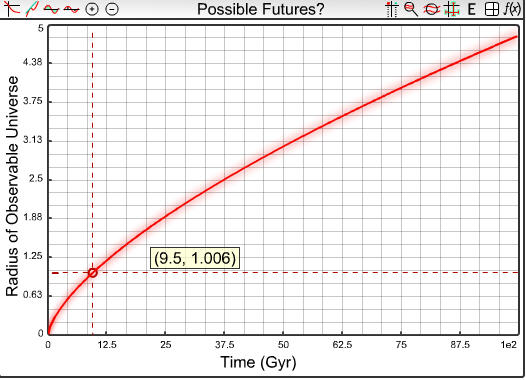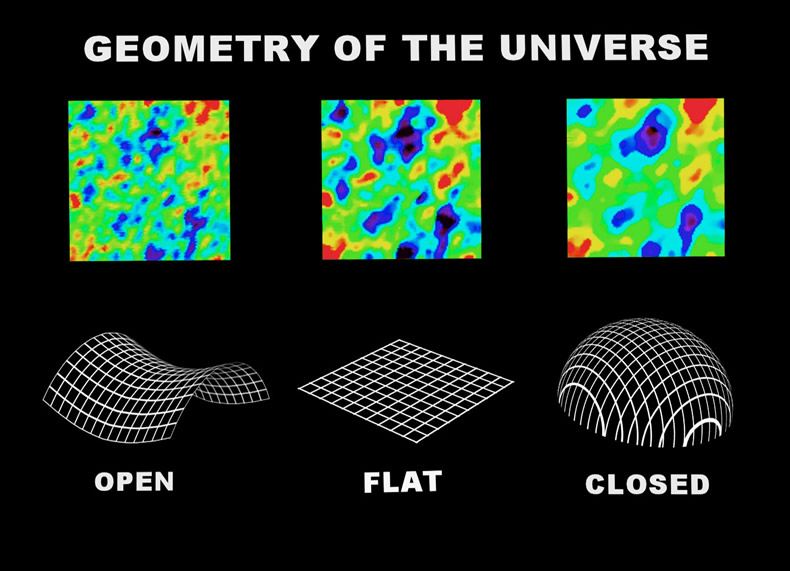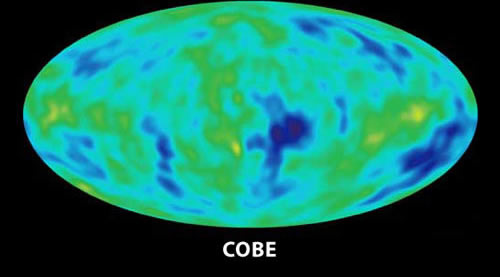Cosmology in the 21st Century
384 - 416
Sometimes things can just be too good to be true! That's the case with modern cosmology. There is something very odd about how close the universe appears to being "flat" and how uniform the background microwave radiation is. These are called, respectively, the flatness and smoothness or horizon problems of cosmology. In addition to these problems there are other strange wrinkles in the story of 21st century cosmology. Hang on!
The Flatness Problem
Why is the geometry of the universe almost flat? This seems like a harmless enough question. Observations, while not at all conclusive, lead us to believe that the universe is very nearly flat. This "nearness" is so unlikely that it has lead some to speculate that the universe is EXACTLY flat. This means that the density of matter is precisely the critical density that we spoke of earlier. Why? The reason is quite simple. If the universe had been any denser than the critical value than it would have collapsed back on itself before now - we wouldn't be here to wonder... On the other hand, if the earlier universe was not dense enough then the galaxies would never have formed - space would have thinned out too rapidly and again we wouldn't be here to wonder ...Calculations have shown that the only way for our universe to have formed and be this "close" to flatness is if the original conditions governing the formation of the universe were very precisely tuned to better than one part in 1049 ! This means that the universe must have started out close to its critical density. If it was too dense then the universe would have stopped expanding and re-collapsed: NO YOU AND ME! If it was not dense enough then the universe would have expanded too fast for stars to form: NO YOU AND ME!
Another way of putting this is that the odds of the universe starting "randomly" and ending up as we are today is about 1 in 1049 . These odds are about as good as winning 7 consecutive lotteries with single tickets each time!
The Smoothness (or Horizon) Problem
A related problem has, ironically to do with the back ground radiation - long considered crowning proof of the Big Bang. The trouble is that the back ground radiation is too uniform. Uniformity means that the universe was at the exactly the same temperature everywhere at the end of the radiation dominated era. But, this requires that every part of the universe be able to exchange heat and reach equilibrium with every other part of the universe. The problem? By the time of recombination the universe was too large to permit this. The only way the universe could appear so smooth today is if it began in an incredibly ordered fashion which again means that the initial conditions had to be tuned to almost incredible precision.
The Inflationary Universe
In the early 1980's Alan Guth of M.I.T. suggested a way around the flatness and smoothness problems. Guth proposed that very early in the history of the universe - (when it was only 10-35s old!!) it underwent a phase of rapid inflation in which its size grew by anywhere from 1020 to 1030 times its original size. Prior to this inflation the entire universe was contained in a dot smaller than the size of an atom. After inflation it was the size of a peach pit!
A crazy idea? No - the idea emerges from the study of the fundamental forces that govern our universe. At the enormous temperature of the Big Bang (greater than 1032 K!!)the 4 fundamental forces in the universe (gravity, electromagnetism, weak nuclear and strong nuclear) were believed to be indistinguishable as one "super-force". The theory that describes the unification of the 4 fundamental forces is called the Grand Unified Theory or GUT. GUT has been the "holy grail" of physics for the past 40 years and tremendous strides have been made in understanding the unification of forces. It is now understood that at high enough temperatures the forces of electromagnetism,and the two nuclear forces are one unified force. The remaining part of the theory is the unification of gravity with the other three. This is illustrated in Figure 15.8. At the moment of the Big Bang the universe was governed by one "superforce". After 10-43 s - and by a process not yet understood - the gravitational force became distinct from other three. After about 10-35s the universe had cooled enough for the electroweak (the electromagnetic and weak forces had not yet "decoupled") and strong nuclear forces to decouple. This released the energy which caused the rapid inflation to occur.
So how does this help get around the flatness and smoothness problems?
Figure 15.9 is a simple Flash animation illustrating the inflationary universe. |
 |
| Figure 15.8 Time-line of the decoupling of the 4 fundamental forces during the earliest phase of the Big Bang |
| Figure 15.9 The Inflationary Universe. |
Example 15.6 Aside from not being to scale, the animation given in Figure 15.9 contains a serious "error" in its depiction of inflation - what is it?
Solution: You cannot stand "outside" the universe and observe inflation! Clearly this is a limitation of any attempt to visualize inflation or universal expansion. The universe underwent rapid inflation everywhere. Space itself was being created in this phase.
The Age Problem and the Accelerating (and decelerating) Universe
Figure 15.10 provides you with the Since inflationary theory suggests that the universe is flat this also implies that it must contain enough matter to be at the critical density. |
|
| Figure 15.10 |
Example 15.7 The critical density for the universe is 9 x 10-27 kg/m3. Use the applet modelUniverse to investigate the age of the universe. Why is the age that you have found a "problem"?
Solution: If you adjust the density slider to be 9 x 10-27 kg/m3 and use the graph inspection tool you can easily show that a flat universe with a density of 9 x 10-27 kg/m3 has a "Hubble Age" of about 9.5 billion years. This is shown below.
 |
The radius of the universe is "1" when the time since the Big Bang is 9.5 Gyr. This is a problem since many globular clusters are older than this! Example 15.7 helps demonstrate the "age problem". This problem has been solved but in a way very few astronomers anticipated! Data on supernovae brightness collected in the 1990's revealed a startling fact - the universe appears to be accelerating in its expansion. This is contrary to the idea that the gravitational pull between galaxies should be slowing down the rate of expansion. |
So how do we know that universal expansion is accelerating? This result rests on the remarkable uniformity of the brightness of Type Ia supernovae and their use as standard candles. Because they are so bright they can be seen at very high redshift. When very distant supernovae brightnesses are measured they are found to be fainter than what we would expect based on their redshift "z-value". In other words they are farther away than astronomers expected. This can be interpreted to mean that the universe is expanding faster now than when the supernovae events took place. When astronomers look even farther out, however, the reverse is seen! Now the supernovae are a bit brighter than expected. This means that in the very early universe the rate of expansion was decelerating! So - what's this all mean? In the early universe galaxies were close enough that their gravitational attraction for each other did slow down the expansion rate - BUT - there was another force at work pushing the galaxies apart. We do not understand this force at this time but the evidence for it is in the supernovae data. At some point about 6 billion years ago the universe switched from decelerating to accelerating. We are living in the accelerating phase of cosmic history.
The Cosmological Constant and Dark Energy
In Einstein's original work on gravitation and cosmology (1917) he added a term called the cosmological constant to prevent the universe from either expanding or contracting. Einstein assumed that, given the data, the universe was static. However, by changing the value of the Cosmological constant you can produce either an expanding or contracting universe. A value of "0" for the cosmological constant would imply, depending on the density, that the universe would collapse or expand forever. In fact, a positive value for the cosmological constant appears to act like "antigravity" and produces and outward, repulsive force.
After Hubble's discovery of the expanding universe Einstein's cosmological constant looked like a mistake! However, 80 years later there seems to be compelling evidence that there exists something very much like Einstein's cosmological constant after all. All of the data support the conclusion that the universe is flat and that it is accelerating in its expansion. Something must be providing a repulsive force to cause the universe to expand at an increasing rate. That something seems to be related to a recurring theme over the past several chapters. We have have already seen that the visible universe makes up only a tiny fraction of the amount of mass in the universe. This is where dark matter enters the picture. However, if the universe is really flat then even dark matter does not provide enough mass to make the universe flat. Astronomers now believe that approximately 2/3 of the universe is made up of a strange substance called dark energy. It is dark energy that provides the outward repulsive force causes the universe to expand at an accelerating rate. Since mass and energy are equivalent this also explains where the rest of the mass need to produce a flat universe is to be found.
As it now stands, we really don't know what dark energy is. Exotic theories in particle physics suggest that the vacuum itself is not empty but contains a form of energy called the quintessence. If that is the case then the dark energy will cause the universe to expand at every increasing rates and lead to what is termed "The Big Rip"! Most astronomers doubt that dark energy is in this form and that the universe will continue to accelerate outward but at an essentially constant rate of acceleration.
The Large Scale Structure of the Universe
In the previous section you were introduced to the Principle of Isotropy which states that the universe looks the same in any direction. This refers to the universe on the largest scale and is really saying that each part of the universe is essentially the same as any other. On a small scale, however, there is structure. Figure 15.11 shows a map of over 100 thousand galaxies plotted according to their position in the sky and their redshift. The earth is situated at the centre of the map and the dark wedges on either side are the regions of the sky blocked by the Milky Way galaxy.
 |
Figure 15.11 comes from the Sloan Digital Sky Survey and represents the most complete picture of how galaxies, clusters of galaxies and superclusters of galaxies are distributed in the observable universe. The image shows the entire sky. According to the Principle of Isotropy, an astronomer in any other part of the universe would produce a map very similar to this one! What is important to note in this image is that there is structure. The galaxies are distributed in long sheets and filaments which form a complex pattern on the sky. This pattern can be analyzed mathematically and compared to the predictions made by models of the early universe. The structure seen in Figure 15.11 is related to subtle variations that can be detected in the Cosmic Microwave Background. Small variations in density in the CMB at the time of decoupling between matter and radiation |
| Figure 15.11 Part of the Sloan Digital Sky Survey of galaxies. (image credit: M. Blanton and the Sloan Digital Sky Survey.) |
when the universe was 380 thousand years old were the seeds from which the large scale structure that we see today were sown.
You can compare the data from Figure 15.12 with the predictions that cosmological models for universes that are closed, flat or open. The WMAP data strongly supports the conclusion that we are in a flat universe that will expand forever.
 |
| Figure 15.13 A comparison of what different geometries for the universe would predict for the structure of the anisotropy in the Cosmic Microwave Background. (credit: WMAP/NASA) |
By carefully measuring the angular size and number of the temperature variations in the CMB it is possible to rule out many possible models for the universe and to "zero in" on the best model. Figure 15.14 shows how the temperature variation and size are related. The solid line through the data points corresponds to a flat universe and rules out open or closed universes. These data also provide enough information to determine most of the key parameters which describe the universe to a very high precision. These are summarized in Table 15.3.
 |
|
||||||||||||
| Figure 15.14 The solid line through the data points represents a flat, inflationary universe model that fits the data very well. | |||||||||||||
The Future of Cosmology
The successes in cosmology over the past decade have been mind boggling! From the discovery of the accelerating universe to the exquisite data from WMAP and other experiments we now know the age of the observable universe to better than 1% precision. Are the major questions for cosmology answered?
By no means! Any "rich" scientific theory must do more than just answer existing questions - it must also point to new puzzles and problems. As it now stands we know that the universe formed from a "Big Bang" event 13.7 billion years ago and that it underwent a phase of universal inflation at the time when the fundamental forces decoupled. But - approximately 96% of the universe consists of either Cold Dark Matter or Dark Energy and we really don't understand either of these! Also, while we can describe the structure of space as "flat" on cosmological scales, what happened in the very earliest phase of the universe - in the first 10-43 seconds? Notions of "flatness" or curved space carry an implicit assumption that the universe is "continuous" - that we can define as small a region of space as we want (this is called mathematical continuity). However, the strange world of quantum physics suggests that on a scale much smaller than the nucleus space itself becomes "quantized". New cosmologies are currently being developed that are grappling with the union of quantum physics and gravity and will, no doubt supplant our current understanding of the universe.

To understand the most recent questions and answers in cosmology.
18.3,4
